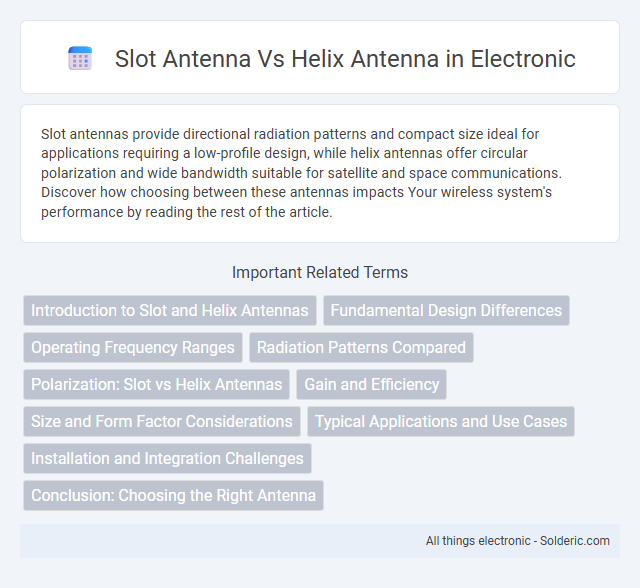Slot antennas provide directional radiation patterns and compact size ideal for applications requiring a low-profile design, while helix antennas offer circular polarization and wide bandwidth suitable for satellite and space communications. Discover how choosing between these antennas impacts Your wireless system's performance by reading the rest of the article.
Comparison Table
| Feature | Slot Antenna | Helix Antenna |
|---|---|---|
| Design | Rectangular or circular slot cut in a metal sheet | Helical wire wound in a spiral shape |
| Polarization | Linear polarization | Circular polarization |
| Bandwidth | Moderate bandwidth | Wide bandwidth |
| Gain | Low to moderate gain (typically 6-9 dBi) | High gain (up to 12-15 dBi) |
| Radiation Pattern | Broadside with nulls perpendicular to slot | Directional along the axis of the helix |
| Applications | Radar, microwave communications, RFID | Satellite communication, space telemetry, GPS |
| Size | Compact and planar | Larger size due to helix length |
| Impedance | Typically 50-75 Ohms | Typically 140 Ohms |
Introduction to Slot and Helix Antennas
Slot antennas feature a narrow rectangular slot cut into a conductive surface, radiating electromagnetic waves with linear polarization and compact size, ideal for radar and communication systems. Helix antennas consist of a conducting wire wound in a helical shape around a central axis, providing circular polarization and wide bandwidth suited for satellite and space applications. Both antennas offer distinct polarization and radiation characteristics, influencing their selection based on specific frequency bands and application requirements.
Fundamental Design Differences
Slot antennas feature a rectangular or circular slot cut into a metal surface, relying on the slot's dimensions and shape for resonant frequency and radiation patterns. Helix antennas consist of a wire wound in a helical shape around a cylindrical form, using its pitch, diameter, and number of turns to dictate gain, bandwidth, and polarization. Understanding these fundamental design differences helps optimize Your antenna choice based on application-specific requirements like size, frequency, and radiation characteristics.
Operating Frequency Ranges
Slot antennas typically operate efficiently in the UHF to microwaves frequency range, approximately from 300 MHz to 30 GHz, making them suitable for radar and communication systems. Helix antennas cover a broader band, extending from VHF through UHF and into the microwave frequencies, roughly 100 MHz to 3 GHz, often favored for satellite and space communications. Your choice depends on the desired operating frequency, where slot antennas excel at higher microwave bands and helix antennas provide versatility across lower to mid-range frequencies.
Radiation Patterns Compared
Slot antennas typically exhibit bidirectional radiation patterns with strong broadside lobes, making them ideal for applications requiring narrow beamwidth in a specific plane. Helix antennas often produce circularly polarized radiation with an axial mode pattern characterized by a main lobe along the antenna axis and significant directivity. The choice between slot and helix antennas depends on desired coverage: slot antennas suit planar, line-of-sight communication, while helix antennas excel in satellite and spacecraft links due to their circular polarization and wide beamwidth.
Polarization: Slot vs Helix Antennas
Slot antennas typically exhibit linear polarization due to their planar structure and field distribution, making them ideal for applications requiring stable, directional signals. Helix antennas, characterized by their helical geometry, commonly produce circular polarization, enhancing signal reception in multipath environments by reducing polarization mismatch. This difference in polarization attributes directly impacts antenna selection based on communication system requirements and signal propagation conditions.
Gain and Efficiency
Slot antennas typically offer moderate gain ranging from 6 to 9 dBi with high efficiency due to their planar structure and low loss materials. Helix antennas can achieve higher gain, often exceeding 12 dBi, especially in axial mode, but they may exhibit slightly lower efficiency due to their three-dimensional design and increased conductor losses. The choice between slot and helix antennas depends on the required gain-efficiency balance for specific applications such as satellite communication or radar systems.
Size and Form Factor Considerations
Slot antennas are typically compact and low-profile, making them ideal for applications requiring minimal space and sleek design, such as in handheld devices or aerospace systems. Helix antennas, while larger due to their spiral structure, offer a three-dimensional form factor that enables circular polarization and broader bandwidth but may not suit size-constrained environments. Your choice between these antennas should consider the spatial constraints and desired radiation properties to optimize performance and integration into your specific device or system.
Typical Applications and Use Cases
Slot antennas are commonly utilized in radar systems, satellite communications, and aircraft due to their compact design and wide bandwidth, making them ideal for embedded applications requiring planar configurations. Helix antennas excel in satellite and space communications, GPS systems, and telemetry because of their circular polarization and high gain, which enhance signal reliability over long distances. Your choice between these antennas depends largely on whether compact form factor or polarization performance is critical for your specific wireless communication needs.
Installation and Integration Challenges
Slot antennas present installation advantages due to their low profile and ease of surface mounting on metallic structures, making them ideal for compact or conformal applications. Helix antennas, while offering excellent circular polarization and wide bandwidth, require more space for proper axial mode operation and often need precise alignment, complicating integration in tight or irregular environments. Your choice depends on balancing the ease of installation with performance needs, as slot antennas integrate seamlessly in space-constrained setups, whereas helix antennas demand careful positioning and support structure.
Conclusion: Choosing the Right Antenna
Choosing the right antenna depends on your specific application requirements and environmental conditions. Slot antennas offer compact size and good bandwidth suitable for planar surfaces, while helix antennas provide circular polarization and high gain ideal for satellite communications. Understanding your signal directionality and polarization needs will help you select the optimal antenna for your wireless system.
slot antenna vs helix antenna Infographic

 solderic.com
solderic.com